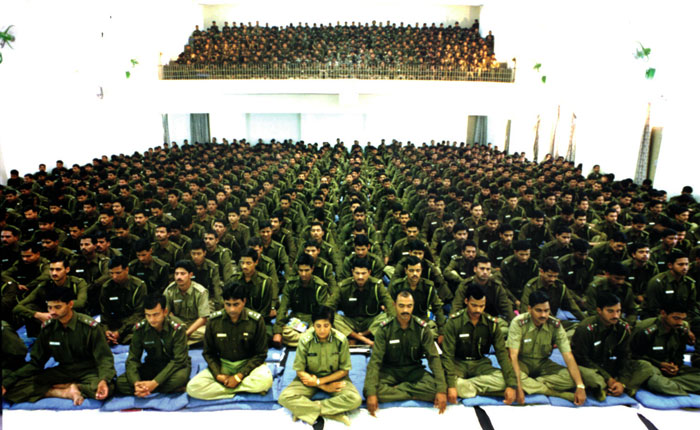
Vipassana Meditation Taught in Prisons in India
In 1975, three courses in Vipassana meditation were offered in a prison environment in Jaipur, India. Although the courses were successful, the program was not continued, and it was not until almost fifteen years later that Vipassana meditation was taught at another prison in India.
During the last half of the 20th century, New Delhi’s Tihar Jail, which is one of the largest prisons in Asia, with about 9000 inmates, was at its worst, and considered one of the most dangerous in the Third World. The jail had horrendous accommodations, with beds made of stone, and stagnant pools of water used as baths and toilets. In the early ’90s, Kiran Bedi, a revolutionary new warden, arrived at Tihar and declared that she wanted the jail to be a spiritual retreat for the prisoners and not a breeding ground for criminals. In 1993, Ram Singh conducted a course in Vipassana with 96 prisoners and 23 jail staff participants. Then, in 1994, arrangements were made for four simultaneous courses in Vipassana. Kiran Bedi brought in S. N. Goenka and his wife, with 13 assistants — and the results were impressive. The atmosphere of the jail began to transform with each course that was taught, and by the mid-1990s Vipassana had become a major force within the prison.

The film Doing Time Doing Vipassana was produced by Israeli filmmakers from 1994 to 1995, and captured the extraordinary changes that took place at Tihar after hardened criminals experienced ten days of silent meditation.
This award-winning documentary was shown internationally, and the jury of the San Francisco International Film Festival wrote, ”The teaching of this meditation as a transformation device has many implications for people everywhere, providing [that] the cultural, social, and political institutions can embrace and support its liberating possibility.”
Vipassana in American Jails
Lucia Meijer, director of a Seattle-area jail that specializes in rehabilitation, had tried various programs over the years to help returning offenders develop new ways of behaving. She became interested in Vipassana when she heard about the success it had had in the lives of prisoners in Indian jails. After taking a course in Vipassana, she felt certain that it would have a beneficial effect on her inmates. She also had her staff go through the program, since she felt that they had to experience it before they offered it to the inmates.
While all of the inmates in this Seattle-area jail were told about Vipassana, not all of them chose to participate in the program. Some of the inmates dropped out of the program because of the physical and mental demands of the practice. Others said that the practice transformed their lives. Many spoke with enthusiasm about the program and said that it helped them avoid returning to old drug habits, and gave them a method of controlling their anger.
The fact that Vipassana was so effective in the Seattle-area jail impressed Sheriff Hennessey, who wanted to try it out in a San Francisco jail. Harry Snyder, a lawyer and consumer advocate trained by Goenka, devoted himself to lobbying efforts to bring Vipassana to jails in the United States, and arranged a meeting of the wardens of these two jails. As a result of this meeting, Hennessey agreed to work out the logistics for a program of Vipassana in San Bruno.
The film Changing from Inside depicts the introduction of Vipassana into the Seattle-area jail, and was made primarily for prison administrators. It shows seven women inmates practicing total silence for ten days, ten hours each day. The meditation leads them deep into themselves and helps them gain insight in dealing with the world around them.
The North American Vipassana Prison Course Program
As success stories circulate about the benefits of offering Vipassana meditation in prisons in India and the United States, other countries are also considering implementing similar meditation programs.
The North American Vipassana prison course program is available at no charge to the participants or the facility where the course is held. The one requirement is that at least one person on the correction facility staff of the prospective institution must take a 10-day course in Vipassana meditation. It is also necessary for the facility to provide a vegetarian menu, as well as housing for the inmate participants.
Additional Information
See the Vipassana Meditation Website for information about meditation taught by S. N. Goenka and his assistant teachers.
For further information about the North American Vipassana prison course program, prison personnel can contact one of the coordinating teachers: Rick and Gair Crutcher by fax at 206-522-8295, Harry and Vivian Snyder by fax at 415-383-7739, or Thomas and Tina Crisman by fax at 214-855-4300.
Further Reading
”County Jail No. 3 is a hellhole. Can an ancient, intense form of meditation improve life for the inmates?” by Joel P. Engardio, SF Weekly. December 20, 2000.
The Foundation of the Empire of Truth, by Anagrika Dharmapala, (1914).
What Buddhism Is Not, by Anagrika Dharmapala, (Maha Bodhi Journal Vol. 34, November 1926).
Source http://netmar.com





Comments are closed.